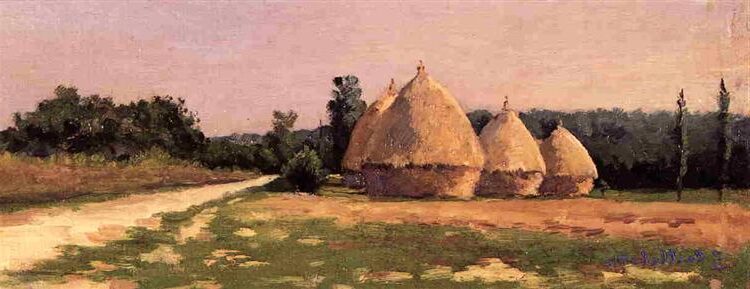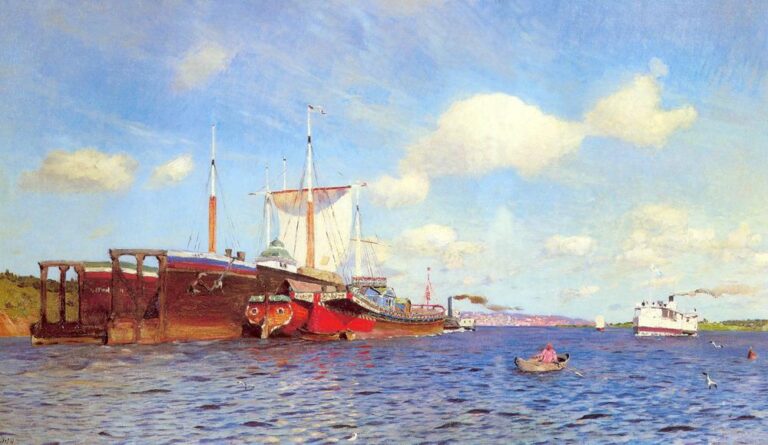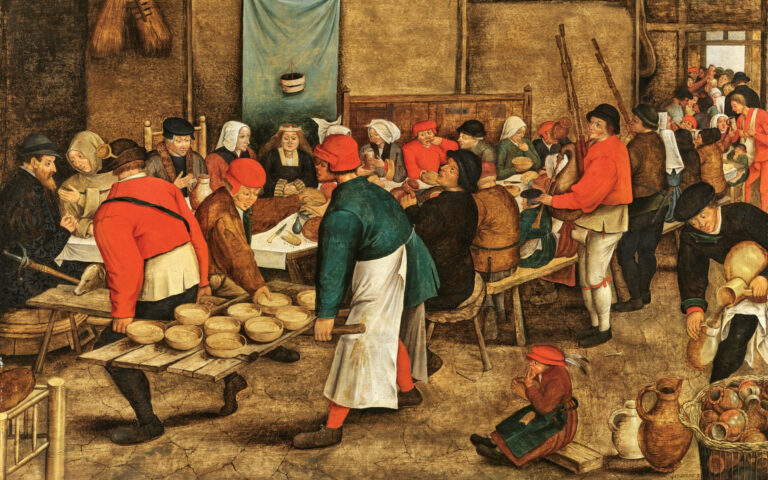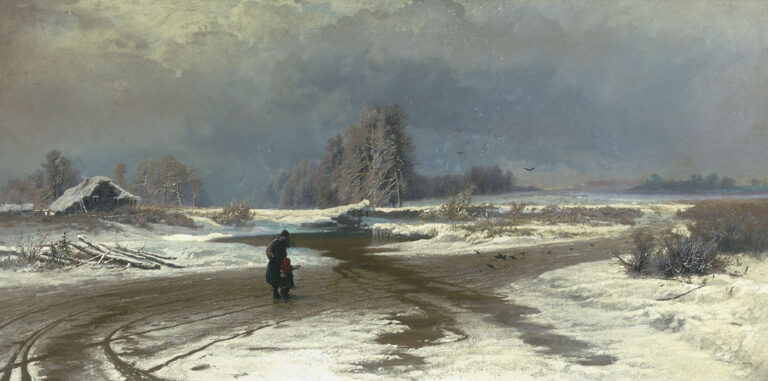Grant Wood Paintings: Exploring Iconic American Artworks
Born: February 13, 1891, Iowa, United States
Death: February 12, 1942, Iowa, United States
Art Movement: Regionalism
Nationality: American
Influenced By: Jan van Eyck
Institution: Académie Julian, Paris, France, School of the Art Institute of Chicago (SAIC), Chicago, IL, US
Grant Wood Paintings: Exploring Iconic American Artworks
Life and Early Work of Grant Wood
Grant DeVolson Wood, an American painter, is known for depicting the Midwest in his artworks. His life and career encompass significant influences and contributions to American art.
Birth and Education
Grant Wood was born on February 13, 1891, in Anamosa, Iowa. He spent his early years on his family’s farm. After his father’s death in 1901, his family moved to Cedar Rapids.
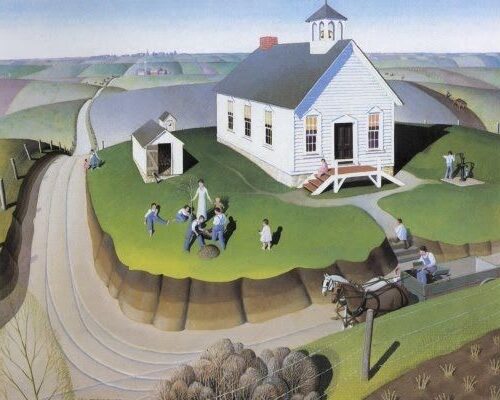
Arbor Day (1932) by Grant Wood
Wood’s interest in art emerged early, leading him to pursue formal education at the School of the Art Institute of Chicago. His education continued with various art classes and experiences, which helped shape his artistic style.
These formative years laid the foundation for his unique approach to Regionalism, a movement that celebrated rural American life.
European Influence and Artistic Development
Wood traveled to Europe, where he encountered various art styles, including Impressionism and the works of the Northern Renaissance. A significant stint was his time in Munich, where he absorbed European techniques and ideas.
This exposure profoundly influenced his artistic development, reflecting in his precise and detailed approach. Despite international inspirations, he returned to the Midwest with an intent to create art that resonated with American themes, blending European precision with Midwest sensibilities.
Establishing the Stone City Art Colony
In 1932, Grant Wood co-founded the Stone City Art Colony near Anamosa, Iowa. This venture aimed to provide artists with a place to collaborate and develop their craft.
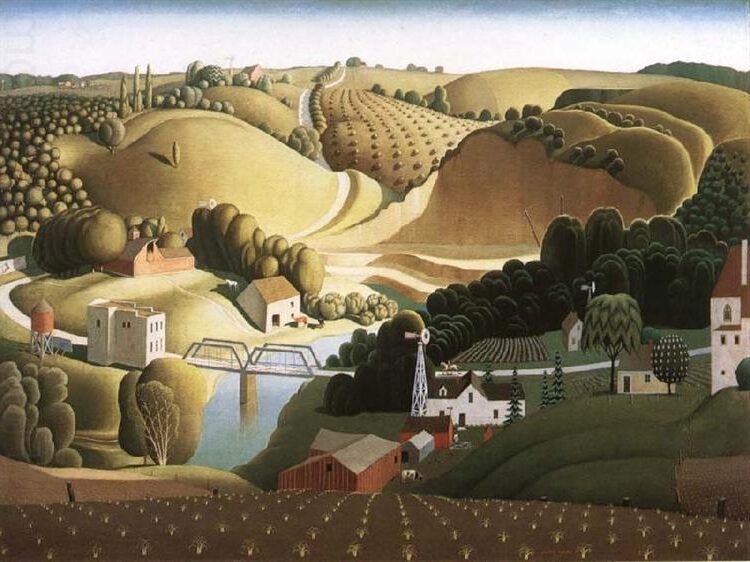
Stone City, Iowa (1930) by Grant Wood
Under his leadership, the colony became a hub for regional artists, promoting the principles of Regionalism. His initiative reflected a commitment to nurturing local talent and embracing the Midwest’s cultural heritage.
The colony’s influence was significant during the Great Depression, as it offered artists an opportunity for artistic growth and community connection.
Prominent Themes in Grant Wood’s Artwork
Grant Wood’s paintings captured the essence of the American Midwest with a focus on familiar landscapes and the rural communities that thrived there. His work displays a blend of realism and regionalism, drawing influence from both European and American art movements. Wood’s unique perspective offers a distinct view of rural life during his time.
Depictions of the American Midwest
Grant Wood’s paintings often highlight the beauty and simplicity of rural American life. His use of stylized landscapes, such as the “Iowa Cornfield,” is a testament to his admiration for the heartland.
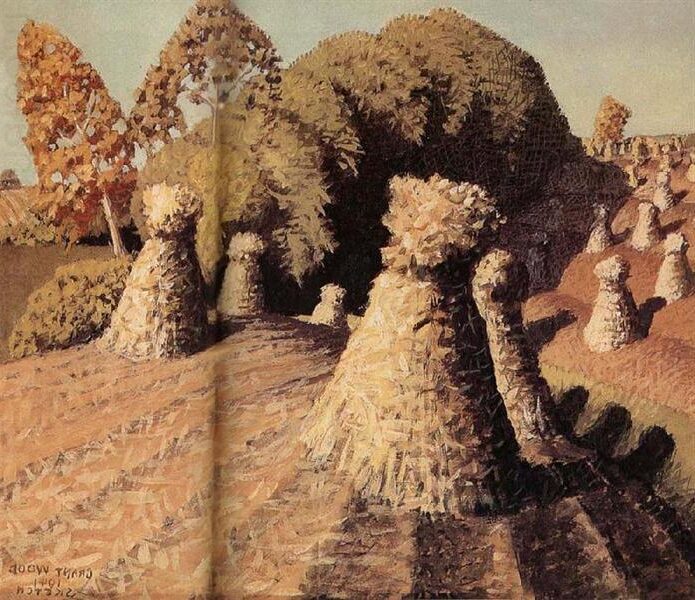
Iowa Cornfield (1941) by Grant Wood
Wood’s “American Gothic,” one of his most famous works, embodies the essence of Midwest values. The painting features a stern farmer and his daughter, symbolizing strength and resilience. His artwork frequently portrays elements like farms, barns, and open fields, symbolizing his deep connection to this region.
Portrayal of Small-Town Life
Wood expertly captured the essence of small-town life through familiar characters and scenes. His painting “Woman with Plants” emphasizes the quiet, domestic life led by many in rural areas.
Wood brought to life ordinary people such as farmers, financiers, and homemakers, highlighting their roles in local communities. His works reflect the social fabric and everyday experiences of rural towns during the Great Depression. Wood’s keen eye for detail and subtle humor allowed him to depict these scenes with warmth and authenticity.
Influences of European and American Movements
Wood’s work was notably influenced by Northern Renaissance art, evident in the clarity and precision of his painting style. Artists like Jan Van Eyck inspired his use of detailed realism.
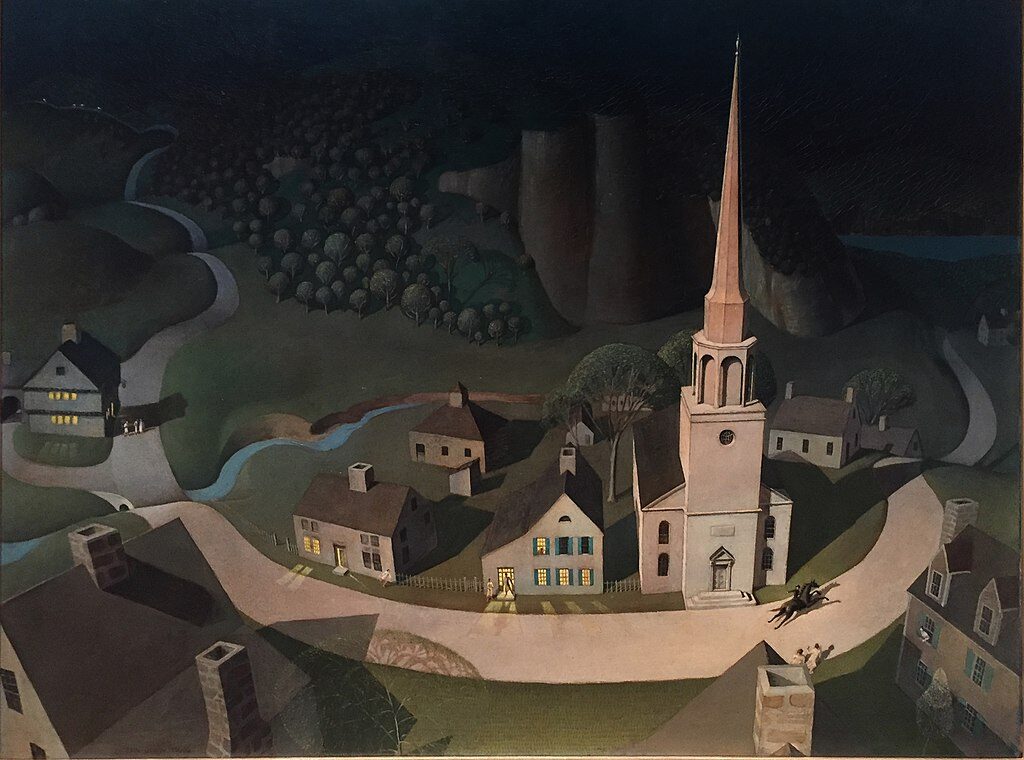
Midnight Ride of Paul Revere (1931) by Grant Wood
Furthermore, his interplay with American artistic movements is evident as he rejected European avant-garde styles in favor of a more realistic style rooted in regional themes.
Wood’s “Midnight Ride of Paul Revere” reflects his interest in American history, combining realism with mythic storytelling. His embrace of regionalism was a counterpoint to Impressionism and Post-Impressionism, focusing instead on subjects recognizable to the American public.
Significant Works and Artistic Legacy
Grant Wood‘s body of work is crucial to the Regionalist Movement, capturing the essence of the rural American Midwest. His paintings blend a unique style with vivid narratives, achieving both artistic acclaim and cultural significance.
The Iconic ‘American Gothic’
‘American Gothic’ is one of Wood’s most recognizable pieces. Painted in 1930 and housed at the Art Institute of Chicago, it features a stern farmer holding a pitchfork beside his daughter, though many assume it’s his wife.
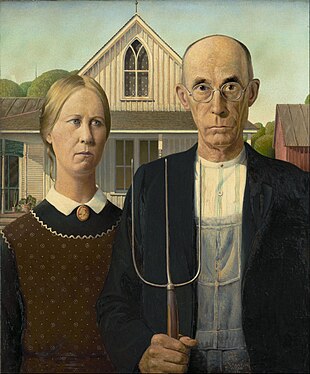

The painting is renowned for its detailed depiction and somewhat satirical take on rural American life. This work is often celebrated for its combination of “Carpenter Gothic” architecture and the stoic expressions of its subjects, becoming an icon of early 20th-century American art.
Other Notable Paintings
Wood’s portfolio extends well beyond ‘American Gothic’. Victorian Survival captures the essence of Wood’s appreciation for detail and historic reference.
Death on Ridge Road is another significant piece illustrating his narrative style through dramatic action. His painting Revolt Against the City reflects his preference for rural settings over urban environments.
Many of his works depict scenes from his childhood in Iowa, grounding them in everyday Midwestern life.
Contribution to American Art and Culture
Wood’s contributions to American art are significant, as he helped shape the identity of the Regionalist Movement. Through his work, he crafted a visual narrative that articulated both the beauty and the challenges of rural American life.

Dinner for Threshers (1934) by Grant Wood
His 1934 painting Dinner for Threshers offered insights into farm life, portraying rituals like the harvest. His art received renewed interest in 1985 with increased public exhibitions.
Wood’s influence extended beyond his own time, fostering an appreciation for regionalism and uniquely American narratives in art.
Techniques and Artistic Style
Grant Wood’s approach to painting combines detailed realism with a distinctly American perspective. His unique technique involves both adapting influences from European art and crafting a singular vision of the American Midwest.
Adaption of European Techniques
Wood took inspiration from the precision and clarity of Northern Renaissance Art. This influence is evident in how he structures his compositions, meticulously arranging each element with care.
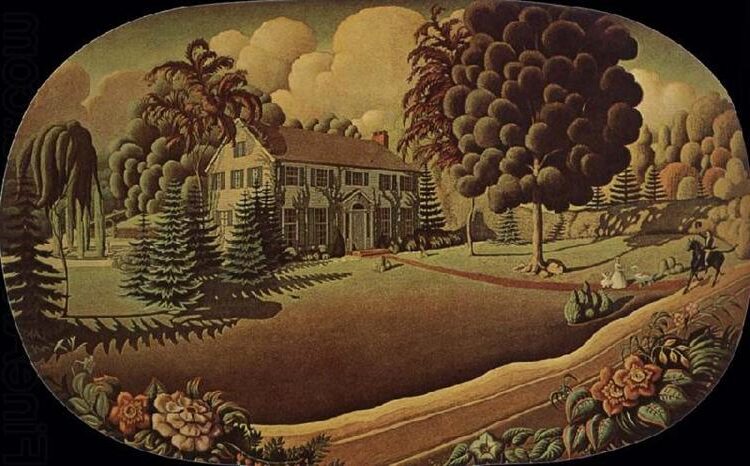
Overmantel Decoration (1930) by Grant Wood
His realist style showcases detailed brushwork, reflecting the intricate methods of artists like Flemish and Dutch masters.
Wood’s technique often includes layering, which creates depth and texture. By adopting these methods, along with vibrant color palettes, he sets a distinctive tone in his work while maintaining precision. This links him to fellow Regionalist painters like John Steuart Curry and Thomas Hart Benton, focusing on capturing the essence of ordinary life.
Development of a Unique American Vision
While heavily influenced by European styles, Wood developed a vision grounded in the American Midwest. He depicted rural settings with a focus on simplicity and community values.
This perspective was part of the Regionalist movement, which celebrated local American themes and rejected European abstraction.
Wood often highlighted everyday scenes, bringing out beauty in ordinary landscapes. He even worked in decorative arts, like stained-glass windows, and mural paintings, which expanded his artistic repertoire.
Through these endeavors, he consistently captured the spirit and character of American life, setting a benchmark in American art history.
Grant Wood’s Impact and Recognition
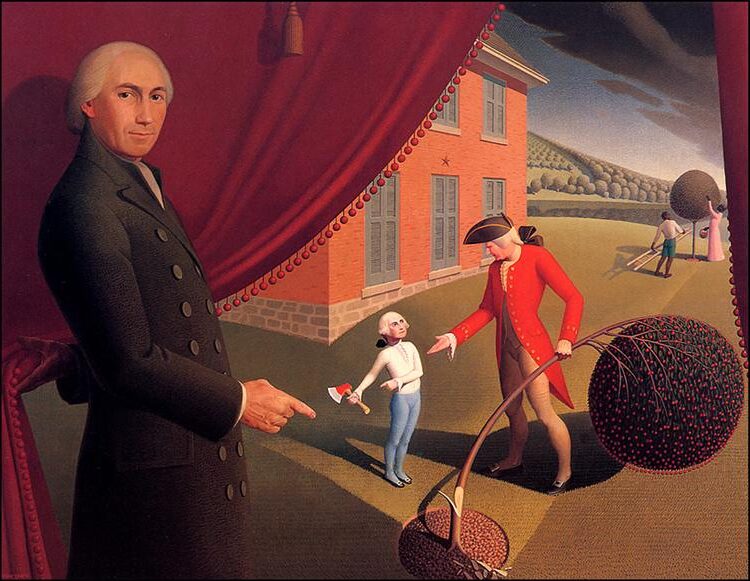
Parson Weems’ Fable (1939) by Grant Wood
Grant Wood played a key role in the development of American art by focusing on rural themes and Midwestern life. He is best known for his painting American Gothic, which became an icon of 20th-century American art. His contributions extend beyond painting, with involvement in various public art initiatives and a lasting influence that continued even after his passing.
Involvement in Public Art Initiatives
Grant Wood was actively engaged in public art, exemplifying his dedication to community-centered projects. He was a member of the Public Works of Art Project, a program during the Great Depression that employed artists to create public art.
Through this initiative, Wood aimed to enrich the cultural community and make art more accessible.
Moreover, Wood was associated with the Arts and Crafts Movement, where he advocated for handcraftsmanship. He founded the Stone City Art Colony to teach and promote regional art.
Wood’s efforts with The Handicraft Guild also demonstrated his commitment to fostering local artistic talent. These initiatives underlined his belief in the social value of art.
Posthumous Recognition and Influence
After his death due to pancreatic cancer in 1942, Grant Wood’s influence continued to grow. His work significantly impacted the Regionalist movement, and his paintings are held in high regard at institutions like the Figge Art Museum.
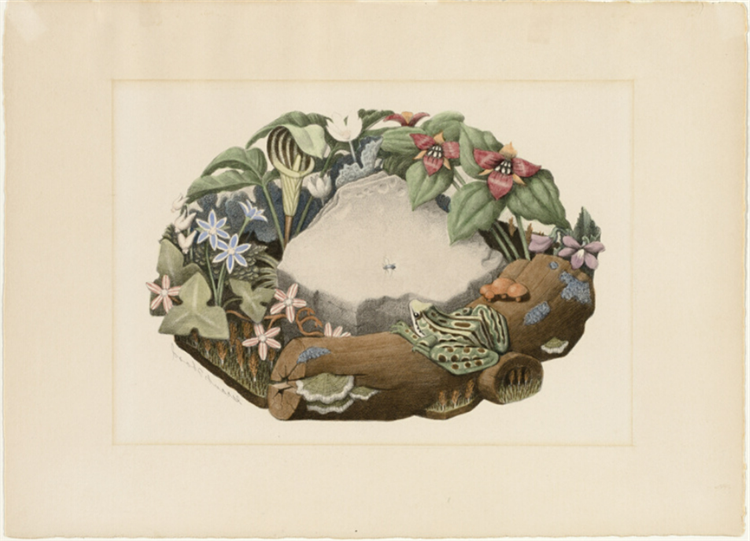
Wild Flowers (1939) by Grant Wood
He is buried at Riverside Cemetery in Iowa, where admirers of his work often pay their respects.
Although he passed away in the early 20th century, Wood’s legacy endures as a pivotal figure in American art. His portrayal of rural America continues to inspire scholars and artists alike, as highlighted in many Grant Wood biographies.
Frequently Asked Questions
Grant Wood’s work is known for themes reflecting rural American life and a detailed, realistic style. His impact reaches the heart of American art, with works housed in prestigious museums.
What are the key themes in Grant Wood’s artwork?
Grant Wood’s paintings often explore themes of rural and small-town American life. He portrayed the landscapes and people of the Midwest with respect and fondness, emphasizing simplicity and hard work.
Which museum houses the largest collection of Grant Wood’s paintings?
The Art Institute of Chicago houses an extensive collection of Grant Wood’s work. It is notably home to one of his most famous paintings, American Gothic, making it an essential destination for admirers of his art.
What impact did Grant Wood have on American art during his lifetime?
Grant Wood played a significant role in popularizing the Regionalist art movement. By focusing on American subjects and themes, he helped art in the United States shift towards depicting everyday life, moving away from European influences.
How do art historians assess the value of Grant Wood’s paintings?
Art historians consider several factors to assess Grant Wood’s paintings, including historical significance, condition, and provenance. His unique contribution to American art and consistent demand in the art market further highlight their value.
Which of Grant Wood’s works are considered masterpieces besides American Gothic?
Beyond American Gothic, Grant Wood’s celebrated works include Stone City, Iowa, Young Corn, and Arbor Day. These paintings showcase his distinct style and thematic focus on Iowa’s landscape and community.
What stylistic elements are characteristic of Grant Wood’s painting technique?
Grant Wood’s style is characterized by clean lines and a meticulous attention to detail. His use of smooth brushwork and careful composition enhanced the realistic quality of his scenes. This drew viewers into the tranquil world he depicted.




